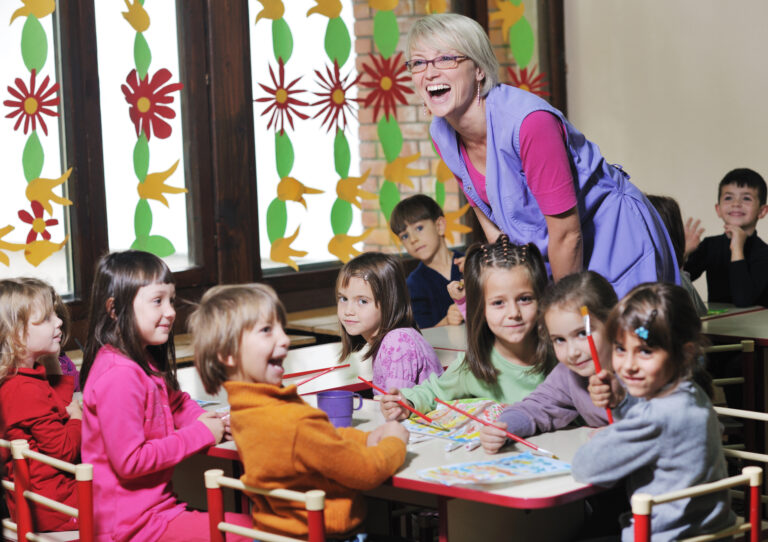Navigating through the vibrant energy of a preschool classroom has been one of the most exhilarating and challenging aspects of my career as a childhood educator.
Transforming what can sometimes feel like chaos into a calm, structured environment is no small feat. Yet, it’s a journey filled with growth, laughter, and learning, not just for the children, but for me as well.
Here, I want to share the classroom management techniques that have been my compass, guiding me and my young explorers toward a harmonious classroom experience.
Establishing a Positive Classroom Atmosphere
Creating a positive learning environment is the cornerstone of effective classroom management. This foundation sets the tone for everything we do.
Embracing a Positive Discipline Approach
In my years of teaching, I’ve found that embracing positive discipline has been instrumental in managing classroom dynamics.
This approach focuses on teaching good behavior through encouragement and mutual respect, rather than punishment.
It’s about guiding children to understand their behavior’s impact and helping them make better choices.
Building Strong Relationships
From what I’ve experienced, the strength of my relationships with each child is directly proportional to the ease of managing our classroom.
Taking the time to get to know each child, understanding their interests, fears, and what makes them tick, has been my secret weapon.
It’s through these connections that I can tailor my approach to meet each child’s needs and motivations.
Creating a Community of Respect
I’ve seen the power of fostering a community where respect is a mutual agreement between me and the children. Setting clear expectations for respectful behavior, modeling those expectations, and acknowledging when they are met, has cultivated an environment where everyone feels valued and heard.
Effective Communication Strategies
Clear, consistent communication is key to steering the classroom from chaos to calm. It’s about ensuring that messages are not just spoken but understood.
Using Age-Appropriate Language
I’ve learned the importance of using language that is accessible to preschoolers. Keeping instructions simple, direct, and positive has minimized misunderstandings and maximized compliance.
It’s been a game-changer in maintaining order during both learning and play.
Non-Verbal Cues
I’ve personally found non-verbal communication to be incredibly effective. Gestures, facial expressions, and even the way I position myself in the room can convey expectations without a word.
This silent language often speaks louder than words in keeping the day on track.
Consistency Is Key
Through my work, I’ve discovered the critical role of consistency in communication. Whether it’s the signals used to gather attention or the phrases that cue transitions, consistency helps children feel secure and understand what’s expected of them, reducing anxiety and misbehavior.
Structuring the Day for Success
A well-structured day is a predictable day, and predictability breeds calm.
Routines and Schedules
In my journey, establishing clear routines and schedules has been paramount. When children know what to expect and what comes next, they’re more likely to engage cooperatively.
Visual schedules and routine songs have been particularly helpful in transitioning smoothly from one activity to another.
Balancing Activities
I’ve tried to balance high-energy activities with quieter ones to manage the energy levels in the room.
This pacing ensures that children have outlets for their energy but also moments where they can wind down, reflecting a natural rhythm to our day that keeps everyone more centered and focused.
Organized Learning Stations
Setting up organized learning stations around the classroom has encouraged self-directed learning and play. I’ve seen how providing clear options and materials at these stations supports children in making choices and engaging deeply with activities, which naturally reduces chaotic moments.
Reflection and Growth
Reflecting on each day and learning from it has been an integral part of my classroom management journey.
Celebrating Successes
I’ve gathered that celebrating the small victories, both my own and those of the children, fosters a positive outlook and motivation to continue improving.
It’s in recognizing these moments of success that we find encouragement and joy in our journey together.
Continuous Learning
In my years of working, I’ve embraced the idea that there is always room to grow and new strategies to try. Attending workshops, reading the latest research, and exchanging ideas with colleagues have kept my approach fresh and effective.
Adapting and Customizing
Every group of children is unique, and what worked one year may not the next. I’ve seen the importance of being flexible and willing to adapt my strategies to meet the needs of my current class.
It’s this willingness to customize my approach that has allowed me to manage my classroom effectively, year after year.
Final Thoughts
In my journey in childcare, navigating from chaos to calm has been a complex but rewarding adventure.
The strategies I’ve shared here, from fostering a positive classroom atmosphere to implementing effective communication and structuring the day, have been pivotal in creating a harmonious learning environment.
It’s a continuous journey of learning, adapting, and growing, not just for the children, but for me as well.












